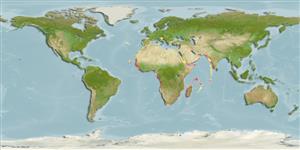Elasmobranchii (haaien en roggen) (sharks and rays) >
Myliobatiformes (Stingrays) >
Dasyatidae (Stingrays) > Dasyatinae
Etymology: Dasyatis: Greek, dasys = rough, dense (Ref. 45335).
More on author: Steindachner.
Environment: milieu / climate zone / depth range / distribution range
Ecologie
marien demersaal; diepte 12 - 65 m (Ref. 4438). Tropical; 37°N - 36°S, 18°W - 35°E
Eastern Atlantic and Mediterranean Sea: Central to South Eastern Atlantic: Morocco, Mauritania to Congo (Ref. 33465) to Natal, South Africa (Ref. 5578); Mediterranean Sea: the records are patchy along the northern coast of Africa, and in Aegean Sea and Levantine Basin, most likely due to misidentification with other Dasyatidae spp. (Ref. 122045 and others cited).
Grootte / Gewicht / Leeftijd
Maturity: Lm ? range ? - ? cm
Max length : 74.5 cm TL mannelijk / geslacht onbekend; (Ref. 123700)
Korte beschrijving
Determinatiesleutels | Morfologie | Morfometrie
Dorsale stekels (totaal) : 0. Conspicuous bright blue blotches and branching lines on a golden brown disc; snout and disc angular, and tail less than twice body length with a short upper caudal finfold, and a longer lower one falling far in front of tail tip; disc without thorns; usually one sting (Ref. 5578). Underside white, tail darker and without bands (Ref. 5578).
Close inshore, found on sandy beaches and in shallow bays (Ref. 5578), sometimes near rocky reefs (Ref. 12951). Found in deeper offshore areas during the winter season (Ref. 12951). Feeds on crabs, mantis shrimps, amphipods, worms, and fishes (Ref. 12951). Ovoviviparous (Ref. 50449). Minimum depth reported from Ref. 4438. Disc width measures 30 cm. Its thorny, venomous hooks can cause painful injuries (Ref. 5377).
Levenscyclus en paargedrag
Maturities | Voortplanting | Spawnings | Egg(s) | Fecundities | Larven
Exhibit ovoviparity (aplacental viviparity), with embryos feeding initially on yolk, then receiving additional nourishment from the mother by indirect absorption of uterine fluid enriched with mucus, fat or protein through specialised structures (Ref. 50449). With 1 to 4 in a litter (Ref. 12951). Distinct pairing with embrace (Ref. 205).
Cowley, P.D. and L.J.V. Compagno, 1993. A taxonomic re-evaluation of the blue stingray from southern Africa (Myliobatiformes: Dasyatidae). S. Afr. J. Mar. Sci. 13:135-149. (Ref. 33465)
Status op de Rode Lijst van het IUCN (Ref. 130435)
Gevaar voor de mens
Harmless
Gebruik door de mens
Visserij: van geen belang; sportvis: ja
Tools
Speciale rapporten
Download XML
Internetbronnen
Estimates based on models
Preferred temperature (Ref.
123201): 20.6 - 28.1, mean 26.3 °C (based on 164 cells).
Fylogenetische diversiteitsindex (Ref.
82804): PD
50 = 0.5002 [Uniqueness, from 0.5 = low to 2.0 = high].
Bayesian length-weight: a=0.00646 (0.00265 - 0.01571), b=3.06 (2.86 - 3.26), in cm total length, based on LWR estimates for this (Sub)family-body shape (Ref.
93245).
Trofisch niveau (Ref.
69278): 3.6 ±0.53 se; based on food items.
Weerstandsvermogen (Ref.
120179): Zeer laag, minimale populatieverdubbelingstijd meer dan 14 jaar (Fec=1-4).
Fishing Vulnerability (Ref.
59153): Moderate to high vulnerability (50 of 100).
